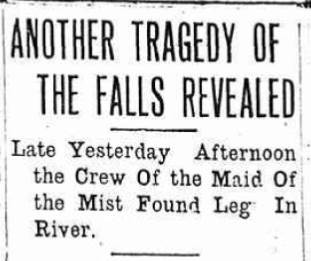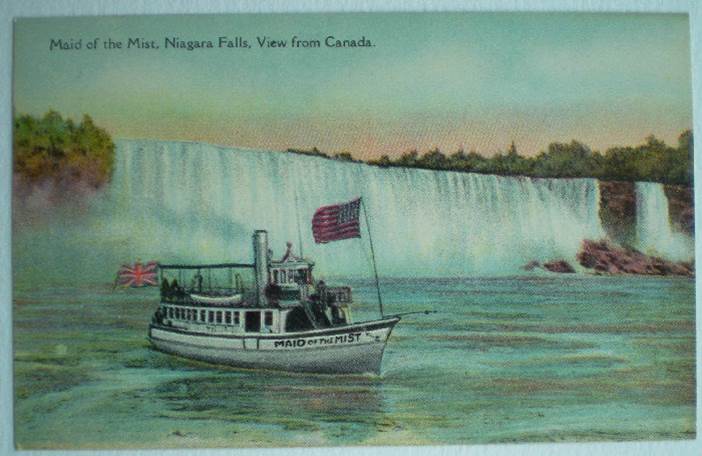by Michelle Ann Kratts

By the 1850’s and 1860’s, well known psychics, such as Emma Hardinge Britten, were coming to Niagara.
“By spirit direction we visited Niagara Falls and Rochester, at both these places our spirit friends made important declarations.”
In 1850, the Spiritual Philosopher pondered the idea of the “fascination with a sense of danger.” “Persons may be fascinated with beauty, music, gold or the love of money; and also by the sense of dangers.” It went on to tell of a young lady, who had been so “fascinated” looking over the precipice at Niagara Falls that she lost her self control and was “dashed to pieces on the rocks below.” Persons in this state should be “Pathetized, and thus the spell may be broken…” And over the years this “fascination” continued to ignite many desperate souls. We find the same story in our papers, over and over again. Different names, different walks of life, but the same sentiment of death.

“Over the Falls…Niagara Falls has another victim. Nina W. Phillips, employed in the city of that name as a domestic, fascinated by the rushing waters, jumped from the Goat Island bridge on Tuesday and was carried over the cataract.”
An event in December of 1855 brought the Spiritualism debate to the forefront in Niagara Falls. A popular lecture series held at the Odd Fellows Hall included a Spiritualist speaker “and the subject was handled without gloves.” The debate grew to such proportions that another series of lectures was held just about a month later “against Modern Spiritualism” at the Clarendon Hotel. Professor Grimes, the “father of the humbug,” discussed “the rise and progress of Spiritualism,” and went onto other topics such as “how mediums are made” and “how the so-called spiritual manifestations were produced.” Interestingly, the editors at the Niagara Falls Gazette did not seem to completely approve of Dr. Grimes’ rebuttal of the Spiritualists. “Professor Grimes has only partially explained the humbug…it only proves that the day may not be far…when science will dispel any other clouds which may now apparently surround the subject.” Ironically, it would not be too far into the future when science, itself, would begin to tap into a whole new set of inquiries and when the scientists, themselves, would become the leaders of the Spiritualist movement.
Perhaps the Civil War had one of the greatest effects upon the Spiritual history of Niagara Falls. It was the largest mass loss of life that the United States had ever experienced and Niagara was not immune. Many of her sons were lost on the battlefield. Spiritualism filled the void for some as it proclaimed that death was not the end; there is survival for man. Even Mary Todd Lincoln, the president’s wife, and a frequent visitor who spent much time at the Cataract House in Niagara Falls, was known to have held séances at the White House.

Mary Todd Lincoln also had a liking for Spirit Photography
It had finally become mainstream and fashionable to contact the dead. The Victorian era also brought forth a romantification of death. A front page obituary from the Daily Gazette reveals more of a ghost story than a death notice as it describes a striking graveside incident. It was written that, as the minister began to read the passage “… “I heard a voice from Heaven,” a roll of thunder from the gathering clouds hushed his voice and added an impressive solemnity to the occasion, which was the more notable as it was the only time the clouds gave forth their voice.” It was during this time that Lily Dale Assembly, the world’s largest and most popular Spiritualist community, was founded in the Town of Pomfret, just a short distance from Niagara Falls.

By the summer of 1866, people were beginning to see the world through different eyes. It seemed that maybe, yes, some things could be possible….In July of 1866, a most strange and event occurred in the yards of the Central Railroad, near the Suspension Bridge, which caused much excitement and certainly piqued the wild imagination of Niagara’s residents. Newspapers across the nation became interested in the reports that 60-70 sheep had been found killed, in most unusual circumstances over a few days time near Niagara Falls. Even as these animals commonly roamed freely throughout the village an occurrence such as this was most startling for the fact that “the sheep were merely bitten in the neck and the blood sucked from the carcass.” No other damage had been done to their bodies. A posse was formed and men with torches were sent out to search for the guilty varmints. Outwardly, it was supposed that a wolf had been the culprit, although it had been believed that the last remnants of wolves had been eradicated years before. The reporting of the incident clearly implied that a supernatural event may have taken place. The general public, at the time, was well aware of vampires and their proclivities. Even as Bram Stoker’s, Dracula, had yet to be written, the short story, “The Vampyre”, conceived by John Polidori, Lord Byron’s physician, in 1819, was popular literature throughout the United States. As Spiritualism grew, many Niagarans seemed to reach into their imaginations for explanations of the unknown. In December of 1880, the Niagara Falls Gazette, under a column titled “Neighboring Counties,” noted that “…a real life vampire, measuring 18 inches from tip to tip, was captured at Silver Creek, Chautauqua County, the other day…” (It may be interesting to note that although vampire bats feed off of slumbering animals such as sheep and goats, they are native to Mexico, Central America, South America and two Caribbean islands and “contrary to what people may think, do not occur in North America, Europe, Asia, Africa and Australia.)” Whatever the reason for the mutilation of the sheep, it was perceived to be an unusual happening.

Another shocking story appeared several years later when the Niagara Gazette reported in bold headlines…”MAID OF THE MIST CREW SAW GHOSTS.”

Sailors from the famous steamboat company had become “greatly concerned” as each evening they were witness to a most unusual scene involving “weird lights” around the eddies of the river near the Canadian wharfs. The sailors began to believe it “must be the ghosts of the drowned haunting the scene of their dissolution.” After Captain R.F. Carter, commander of the boat, saw the weird lights and was, himself, puzzled, he decided to investigate.

Captain R. F. Carter
He came up with an extremely complex explanation involving a wooden tub filled with phosphorescent paint in which drift wood would come into contact with and coincidentally catch fire if the driftwood would happen to toss upon another object, float around, dry in the sun, and break open. It is likely that the sailors stuck with their original theory of ghosts—as it, quite frankly, made more sense. (It may be interesting to note that a news article printed alongside the above “MAID OF THE MIST CREW SAW GHOSTS” contained a report stating that the very same day, July 11th, the crew of the Maid of the Mist secured “a most ghastly object” from the shore of Lake Ontario…a human leg that had been torn from the body at the hip, still wearing a stocking and shoe.)

